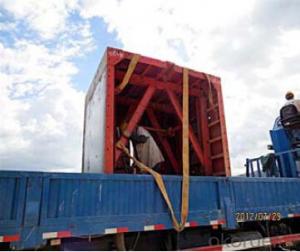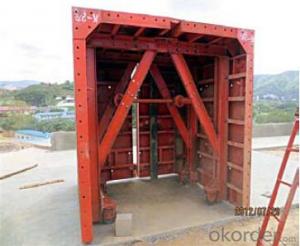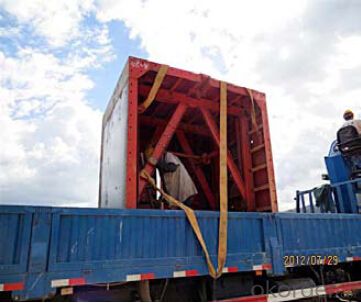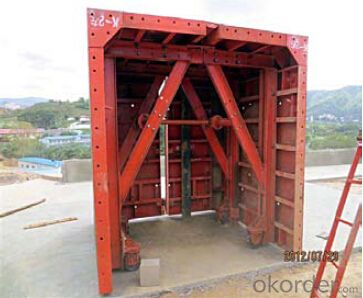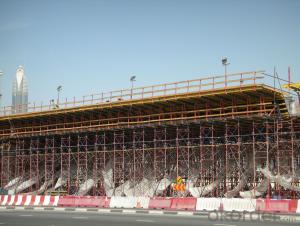Steel tunnel for formwork and scaffolding systems
- Loading Port:
- Tianjin
- Payment Terms:
- TT OR LC
- Min Order Qty:
- 50 m²
- Supply Capability:
- 1000 m²/month
OKorder Service Pledge
Quality Product, Order Online Tracking, Timely Delivery
OKorder Financial Service
Credit Rating, Credit Services, Credit Purchasing
You Might Also Like
Building Tunnel Formwork:
A compositional steel formwork system mainly used in the building which has regular structure
without beams, the excellent formwork system can make the integral pouring for the wall & slab
easily achieved.
Characteristics:
◆ High stiffness, make perfect shape for concrete.
◆ Easy operation, save labor and force.
◆ Fast forming, repeatedly turnover.
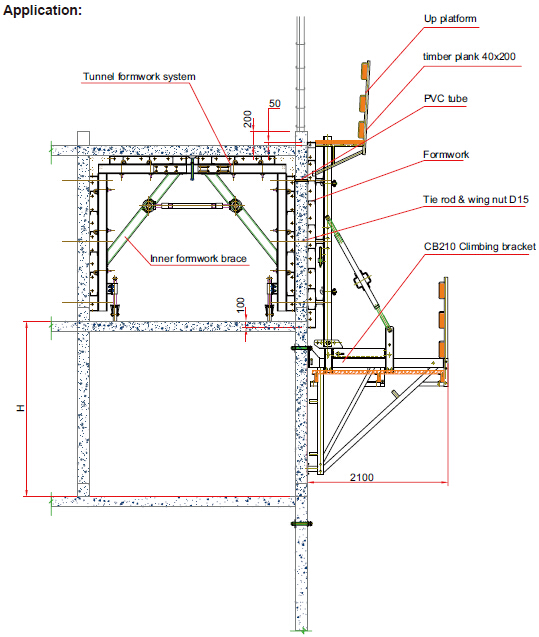
- Q: What are the common challenges associated with steel formwork?
- Some common challenges associated with steel formwork include its heavy weight, which can make transportation and installation difficult, as well as its high cost compared to other types of formwork. Additionally, steel formwork requires skilled labor for assembly and disassembly, and it may require additional time for proper cleaning and maintenance to ensure its longevity.
- Q: How does steel formwork affect the speed of construction?
- Steel formwork can greatly enhance the speed of construction due to its numerous advantages. Firstly, steel formwork is highly durable and can withstand repeated use, allowing for multiple pours to be completed without the need for replacement or repair. This eliminates the downtime associated with traditional timber formwork, where the forms often need to be replaced after only a few uses. Additionally, steel formwork is known for its ease of assembly and disassembly. The modular nature of steel formwork allows for quick and efficient installation, reducing the overall construction time. This is particularly beneficial for large-scale projects where time is of the essence. Furthermore, steel formwork offers excellent dimensional accuracy and stability, ensuring precise and uniform construction. This eliminates the need for excessive rework and adjustments, saving both time and resources. Steel formwork is also known for its ability to handle high concrete pressures. This allows for faster pouring and setting of concrete, as there is no need to wait for the formwork to be fully cured before proceeding to the next pour. This results in faster construction cycles and increased productivity. Lastly, steel formwork is compatible with various construction techniques and can be easily adapted to suit different project requirements. It can be used for a wide range of applications, from simple slabs and columns to complex structures, enabling faster construction of diverse building elements. Overall, steel formwork significantly speeds up the construction process by offering durability, ease of use, dimensional accuracy, and compatibility with different construction techniques. Its ability to handle high concrete pressures and its modular nature contribute to faster construction cycles and increased productivity, making it an ideal choice for efficient construction projects.
- Q: Does steel formwork require any special equipment for installation?
- Yes, steel formwork does require special equipment for installation. The installation process involves assembling the steel panels into the desired shape and securing them together. This typically requires the use of specialized tools such as spanners, hammers, or hydraulic jacks to ensure proper alignment and tightness of the formwork. In addition, heavy-duty lifting equipment such as cranes or forklifts may be necessary to move and position the steel formwork panels safely. The use of special equipment ensures that the installation is done accurately and efficiently, resulting in a sturdy and well-constructed formwork system.
- Q: Are there any safety concerns associated with steel formwork?
- Steel formwork presents a number of safety concerns. One major issue is the weight of the steel panels, as they can be quite heavy and pose a risk to workers during installation and removal. To handle the panels safely, workers must follow proper lifting techniques and utilize equipment like cranes or forklifts. Another concern revolves around the risk of falls, especially when steel formwork is used for high-rise buildings. To prevent accidents, it is essential to implement fall protection measures such as guardrails, safety nets, or personal fall arrest systems. Moreover, steel formwork may have sharp edges or protruding parts that can lead to injuries if mishandled. Reducing the risk of cuts, bruises, or other injuries requires proper training on handling and assembling the formwork. In addition, welding or cutting may be necessary during the installation or modification of steel formwork, introducing hazards like sparks, fumes, or fire. To mitigate these risks, it is crucial to ensure adequate ventilation, wear appropriate personal protective equipment, and adhere to safe welding practices. Lastly, electrical hazards can arise if steel formwork comes into contact with overhead power lines or if electrical tools and equipment are used nearby. Identifying potential electrical hazards and implementing safety measures such as isolating power sources and following safe work practices is vital to prevent electrical accidents. While steel formwork offers numerous advantages in construction projects, it is vital to acknowledge these safety concerns and take necessary precautions to protect workers and maintain a safe work environment.
- Q: How does steel formwork handle different concrete curing methods?
- Steel formwork is highly versatile and can handle different concrete curing methods effectively. Its strength and durability enable it to withstand the pressures exerted by various curing techniques, such as traditional wet curing, steam curing, and precast curing. Steel formwork provides a stable and rigid structure that can maintain the shape of the concrete during the curing process, regardless of the method used. Additionally, steel formwork can be easily adjusted, dismantled, and reassembled, making it suitable for different curing methods and allowing for efficient construction processes.
- Q: Can steel formwork be used for both residential and commercial projects?
- Steel formwork can serve both residential and commercial projects effectively. Renowned for its strength and capacity to bear heavy loads, steel formwork is a flexible and enduring choice extensively employed in construction. Its adaptability enables convenient customization to cater to diverse project demands, irrespective of whether they pertain to residential or commercial ventures. Among its merits are notable advantages like exceptional concrete finish, swift assembly, and extensive reusability. In both residential and commercial construction, steel formwork finds widespread application in foundations, walls, slabs, columns, and beams.
- Q: How does steel formwork handle moisture and humidity?
- Steel formwork is highly resistant to moisture and humidity due to its inherent properties and effective protective measures. The steel used in formwork construction is typically treated with anti-corrosion coatings, such as galvanization or epoxy paint, which create a barrier against moisture penetration. These coatings protect the steel from the corrosive effects of water, preventing rust formation and structural degradation. Additionally, steel formwork systems are designed with tight joints and connections to ensure minimal water ingress. This reduces the risk of moisture accumulation within the formwork, which could potentially weaken the structure or affect the quality of the concrete. Furthermore, steel formwork is non-absorbent, meaning it does not absorb water or humidity. This characteristic prevents swelling, warping, or distortion of the formwork due to moisture exposure. It also ensures consistent and accurate dimensions of the formwork, resulting in precise concrete shapes and finishes. In cases where steel formwork is exposed to high levels of moisture or humidity, such as in marine or coastal environments, additional protective measures can be taken. These may include applying specialized coatings or using stainless steel formwork, which offers superior resistance to corrosion and moisture. Overall, steel formwork is well-suited for handling moisture and humidity. Its resistance to corrosion, non-absorbent nature, and ability to maintain structural integrity even in challenging environmental conditions make it a reliable and durable choice for construction projects.
- Q: How does steel formwork handle concrete curing compounds and sealers?
- Steel formwork is highly resistant to concrete curing compounds and sealers. Due to its non-porous surface, steel formwork prevents the penetration of these chemicals, ensuring that they do not interfere with the curing process or affect the quality of the concrete. Additionally, steel formwork is easy to clean and maintain, allowing for efficient removal of any residual compounds or sealers that may come into contact with it during construction.
- Q: How does steel formwork affect the overall labor requirements of a construction project?
- Steel formwork can significantly reduce the overall labor requirements of a construction project. Its durability and strength allow for faster and more efficient construction processes, reducing the time and effort needed for assembling and disassembling formwork. Additionally, steel formwork is reusable, eliminating the need for repetitive formwork construction and reducing labor costs.
- Q: What are the safety precautions when using steel formwork?
- To ensure the well-being of workers and the successful completion of the project, it is important to adhere to several safety precautions when using steel formwork. These precautions include: 1. Adequate training and awareness: Proper training should be provided to all workers involved in the use of steel formwork. They should be knowledgeable about potential hazards and the correct procedures to follow. 2. Inspection and maintenance: Thoroughly inspect the steel formwork before use to identify any defects or damage. Any weakened or damaged parts should be repaired or replaced. Regular maintenance should also be carried out to keep the formwork in good condition. 3. Proper handling and storage: Due to the weight of steel formwork, appropriate lifting and handling equipment, such as cranes or forklifts, should be used to avoid strain or injuries. When storing the formwork, ensure it is securely fastened to prevent accidents. 4. Fall protection: Implement fall protection measures, such as guardrails, safety nets, or personal fall arrest systems, when working at heights with steel formwork. Workers should be provided with safety harnesses and trained in their use. 5. Secure installation: Ensure the steel formwork is securely installed to prevent collapse or movement during concrete pouring or other construction activities. Follow the manufacturer's instructions and use appropriate bracing and support systems for stability. 6. Adequate signage and barriers: Place proper signage and barriers around the work area to warn others of potential hazards and restrict access to authorized personnel only. This helps prevent accidents and keeps unauthorized individuals away from the site. 7. Personal protective equipment (PPE): All workers using steel formwork should wear appropriate PPE, including hard hats, safety boots, gloves, and eye protection. This protects them from injuries caused by falling objects or sharp edges. 8. Regular communication and coordination: Maintain effective communication and coordination among workers using steel formwork to ensure a safe working environment. Provide clear instructions, hold regular safety meetings, and have emergency procedures in place to keep everyone aware of their roles and responsibilities. By following these safety precautions, the risks associated with using steel formwork can be minimized, and a safe working environment can be maintained for all construction project workers.
Send your message to us
Steel tunnel for formwork and scaffolding systems
- Loading Port:
- Tianjin
- Payment Terms:
- TT OR LC
- Min Order Qty:
- 50 m²
- Supply Capability:
- 1000 m²/month
OKorder Service Pledge
Quality Product, Order Online Tracking, Timely Delivery
OKorder Financial Service
Credit Rating, Credit Services, Credit Purchasing
Similar products
Hot products
Hot Searches
Related keywords
